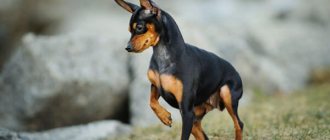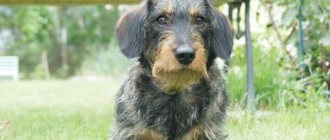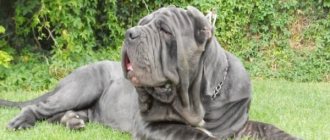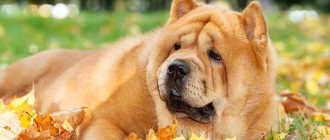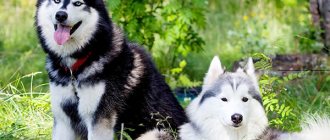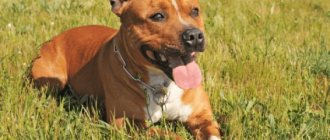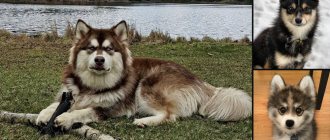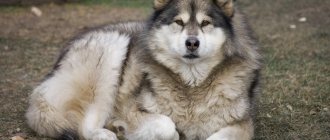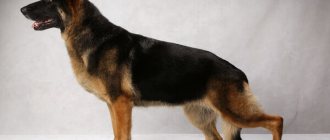The dachshund is a representative of one of the oldest breeds, whose goal was to find and drive burrowing animals.
Dogs have evolved the ability to chase prey over centuries.
Therefore, it is not surprising that the appearance of the animal speaks for itself.
The dogs have an elongated body and short legs, and their squat stature is one of the advantages of these dogs in the field of burrow hunting.
In this article we will give a detailed description of the long-haired dachshund breed and how to care for them.
Origin story
All short dogs with a long body, as a rule, have one ancestor - ancient hounds. And the dachshund is no exception.
But in relation to hounds, a long body was recognized as a disadvantage rather than an advantage - only the long-legged hound was recognized, until this type was used in the field of burrow hunting. For the first time, the disproportionate ratio of the body to the legs was appreciated by German hunters and only later by breeders, from whom the targeted breeding of squat dogs began.
NOTE!
A larger number of remains of dachshund dogs were found in Germany. However, during excavations, skeletons of early dachshunds were also discovered in Greece, Ancient Rome and Egypt.
With the official recognition of the breed (1988), the number of breeders increased, which led to the active spread of the breed throughout the world. Therefore, it is not surprising that active export led to the formation of subspecies of the breed.
For example, the standard longhaired dachshund was created by crossing spaniels with the standard dachshund.
Long-haired rabbit - by mating small dwarf dachshunds, pinschers and toy terriers.
The long-haired dwarf was bred by mating small representatives of the standard long-haired dachshund.
Compared to males, females are characterized by elegance both in terms of head and body. The physique of females is more toned. In terms of height and body length, gender does not play a role, so the proportions remain the same: 1.7-1.8:1.
Interesting facts about the breed
People's opinions about representatives of this breed are divided. Some consider these animals awkward and even ridiculous, while others, on the contrary, love them with all their hearts. In fact, the breed appeared a very long time ago, and it is even considered famous.
What does a long-haired rabbit dachshund look like?
Dachshunds were developed about 300 years ago. This significant event took place in Germany. The main purpose of these animals was to hunt badgers. It was thanks to their small size and short legs that these animals easily climbed into badger holes.
Initially, all dachshunds were black, but thanks to the work of breeders, today there are 12 colors and three varieties of animals with significant differences. There are also two sizes of these animals - miniature and standard.
For your information! The first cloned dog was a dachshund.
Character traits
The character of the long-haired dachshund does not differ much from other representatives of the breed. Along with other relatives, this species is not devoid of hunting traits and is ready to play the role of a guard along with other dogs.
Well oriented in space. This can be understood by the speed with which the dog takes up all the warm and cozy places in the house.
She is also not devoid of a sense of ownership. Therefore, if the owner, without good reason, reaches out to the object the dachshund has chosen, be prepared for a warning growl. A sense of ownership also manifests itself in relation to territory. Most dachshunds show genuine wariness when welcoming new guests into the house.
Expert opinion
Kozhevin Semyon Kirillovich
Expert dog handler.
The first thing that strikes you is character. While other dachshund cousins are stubborn, the long-haired dachshund is characterized by a delicate approach. But, despite its gentleness, the dachshund remains true to its nature and can compromise its principles if circumstances contribute to this. For example, danger. After all, the dachshund is a territorial animal.
Dog character and intelligence
The long-haired dachshund, like the short-haired one, is curious and energetic. The restless dog will not miss a single event that happens in the house or on the street. In addition, the curly pet has the following features:
- Sociability. The dog quickly gets close to people and becomes attached to all family members. He will also quickly become friends with other pets in the house. But the pet chooses only one person as the owner whom it will obey.
- Bravery and daring. The pet will protect its family and the territory of the house from all strangers. Even despite its small dimensions, it will not be afraid of a large enemy.
- Smartness. He is easy to train. The main thing is to spend enough time with it.
Wool and its structure
The dachshund's coat is smooth, even, and shines in the light. It fits tightly to the body, in the area of the throat and lower part of the body the hair is longer, while on the muzzle it is shorter and thick.
If the fur is wavy on the line of the belly and chest, then on the ears it is observed in the form of a fringe. But the fur reaches its greatest length on the underside of the tail, where it resembles a real flag.
Types by coat type
The miniature dachshund has three types of hair . Shorthair type: The coat is short and smooth.
The wire-haired type is characterized by rigidity, thick hair, with undercoat. The dog also has bushy eyebrows, a mustache and a small goatee. The hair is shorter in the crown area and on the ears.
The long-haired type has a soft-to-the-touch coat that is slightly wavy . And in the areas of the body, neck, ears and hind limbs, along with the tail, it is longer.
Accepted standard
The table below shows the standard characteristics of a longhaired dachshund:
| Index | Description |
| Head | Triangular in shape, but not narrow. The forehead is wide, with a marked transition to the muzzle. Developed and strong jaws. |
| Eyes | Small, evenly placed. The predominant palette is brown; pearl and blue are also found. |
| Nose | The lobe is oval in shape, colored brown or black. |
| Ears | Wide, drooping and with rounded tips |
| Teeth | Complete dentition. The teeth are white, even, with large fangs. |
| Body | Muscular, strong, with a deep or pear-shaped chest. |
| Limbs | Well developed joints. The front legs are set closer together than the hind legs. |
| Tail | Continues the line of the spine and is not restricted in movements. |
Distinctive features
There is no separate standard for the Miniature Dachshund. It is a subspecies of the standard breed and is considered its smaller copy: it reaches only 14-21 cm at the withers and weighs 4-5 kg. In addition to height variation, there are varieties based on coat length: smooth-haired, long-haired and wire-haired.
All Dachshunds are distinguished by a very elongated format, low stature and short legs. A similar physique can also be seen in the Basset Hound; in other breeds such parameters are considered defects. The proportions and shape of individual body parts are the same among the subspecies of the breed.
- The head is long, conical, tapering towards the nose. The stop is smooth, the brow ridges are pronounced.
- the muzzle is equal to the length of the skull. The jaw is strong with a full set of teeth and a scissor bite (the upper teeth closely overlap the lower teeth). Lips are thin.
- The nose is large. The color depends on the coat color.
- The eyes are small, almond shaped, set wide and slanting. Chocolate iris .
- The ears are set high, drooping, rather long and thin, rounded at the ends.
- The body is muscular, strong, elongated. The topline is straight and long, the withers are pronounced. The chest is well dropped . The neck is long, carried proudly and without dewlap.
- The tail is short, does not touch the ground, and is set below the back.
- The limbs are short, set wide and straight. The paws are large, powerful, oval with pointed toes. Movements are smooth, hobbling, jerking.
- The smooth-haired coat is: close-lying, straight, fine, smooth; Wire -haired : thick, wiry with dense undercoat; Long -haired : shiny, medium-length, wavy, soft, with a fluffy undercoat.
- Colors. Solid: brown, black, red, sand, bi-color: black and tan or brown and tan, merle: black, auburn or gray with spots, brindle
Dimensions and weight
Common sizes:
| Options | Male | Bitch |
| Height at withers | 27-22 cm | 25-20 cm |
| Weight | 9 kg | Up to 9 kg |
| Size (bust) | More than 35 cm | Up to 35 cm and above |
IMPORTANT!
Standard dachshunds weighing more than 9 kg are not subject to rejection, but do not receive an “excellent” rating. As for obese dachshunds, they are immediately recognized as a marriage.
Marriage or a separate breed?
This dachshund appeared as a result of one work on modifying the breed.
The bet was on reducing the size, during which the breeders preserved the specific advantages of the dog, as well as the predisposition to hunting activities.
The miniature dachshund is recognized, if not as a separate species, then as one of the varieties of the breed, since it was bred purposefully and does not represent mistakes on the part of breeders.
What is the difference from a smooth-haired dachshund?
The smooth-haired dachshund has short, thick, sometimes hard and close-fitting hair; in comparison, the long-haired dachshund has smooth hair and has undercoat. The length of the coat varies depending on the area of the body. If on the lower part of the body the hairline calmly falls down, then on the throat it goes down in the form of a small beard, when the ears are framed with fringe.
The smooth-haired dachshund has three color :
- single color (black, red, beige, etc.);
- two-color;
- marble and brindle.
When, like a long-haired dog, only the first and third options are considered.
Reviews from owners of curly dachshunds
Nika, Moscow:
“A magnificent, stately and beautiful dog. She quickly learns commands and deftly performs tricks. Working with her is a pleasure. The main thing is to have patience and understanding, and then your friend will answer you in kind. A daily walk is our favorite time. And cold weather won’t interfere with this if you have warm overalls.”
Albina, Krasnodar:
“When we arrived at the kennel, I was immediately hooked by this particular dog. Four years have passed since then, and I have never regretted the decision to take her. I always monitor her diet and health to prevent any illnesses. Feeding is easy because we ourselves eat the same natural foods. The dog is incredibly energetic and never sits still. There is not a single corner of the house where he has not visited.”
Photos of main colors
Among the single-color colors of the long-haired dachshund, red (the most valuable), red, fawn and brown are common, which are also not without dark hairs. Regarding the white color, the situation is not clear; on the one hand, this color is not desirable, but rare white spots are still acceptable.
Among others, marble and tiger colors are often observed. In marble, a dark shade predominates (gray, red, black) and small beige and gray spots are welcome. The brindle color is based on red or fawn.
NOTE!
The value of a color is determined by its saturation.
Decorative qualities
Long-haired merle dachshund with blue eyes
The long-haired dog is an object of fascination for different people. Some use these animals in hunting, for others these animals are friends and comrades. When choosing a representative of this breed, everyone should take into account the decorative qualities of these dogs.
Note! Miniature long-haired dachshunds have a calm and balanced character. They are wonderful companions, helpers and friends.
Advantages and disadvantages
Positive aspects of the breed:
- intelligence;
- mind;
- loyal attitude towards others;
- endurance;
- attachment;
- courage and good makings of a security guard;
- innate hunting qualities;
- compactness.
Negative:
- jealousy and resentment;
- tendency to dominate;
- tendency to obesity;
- difficulties with training;
- predisposition to diseases.
Dwarf dachshund: photo, features of the breed
It is no coincidence that this dog received its name, because it has a rather inexpressive size and looks quite miniature even compared to its standard relative. Since the creation of this breed, it was intended that it would also be used for hunting. However, it immediately became clear that such a baby would not be able to win a fight with a badger, so she was taken only for rabbit hunting .
If hunting is not one of your hobbies, and you have long dreamed of having a small lap dog in your apartment, then the dwarf dachshund will be an excellent choice for you. This dog can also bring considerable benefit to owners of private houses who are tired of listening to and putting up with constant visits from their neighbors’ cats, because this little one is strong enough to cope with these uninvited guests. Of course, this dog will demonstrate such hostility only towards other people's cats. She will treat her own people differently, perceiving them as a toy or play partner. There are cases when dachshunds began to take care of kittens, not allowing the mother to get to her offspring. Quite easily they establish friendly contacts with children , as a result the dog quickly becomes the child’s favorite friend.
Life expectancy and health
On average, long-haired dachshunds live 10-15 years. The basis for the length of years is the conditions of detention and genetic heredity.
Dachshunds are one of those dogs that are prone to a number of diseases:
- diseases of the musculoskeletal system;
- diseases of the spine (pinched spinal nerves);
- intestinal diseases (urolithiasis);
- heart and kidney diseases;
- hormonal disorders;
- hernia;
- diabetes;
- dysplasia;
- eye diseases (cataracts and glaucoma);
- obesity;
- osteochondrosis;
- colds and hypothermia;
- Swimmer's or turtle chest syndrome.
The rabbit variety of dachshunds is prone to ailments that affect all miniature dogs:
- skin diseases;
- atlantoaxial instability (displacement of the second cervical vertebra relative to the first);
- hypoglycemia (lack of blood sugar levels);
- problems with the muscle corset;
- Difficulty in replacing baby teeth with molars.
Hunting
It is not customary to hunt with a dwarf dachshund, since the breed is too small to work on a burrowing animal, especially if we are not talking about cowardly young animals, but about foxes and badgers with experience. Of course, once in the hole, the dachshund will try his best to chase the prey, but the animal is unlikely to be impressed by the size of its pursuer. Nevertheless, some owners practice forays into the forest and field with the breed, but more for entertainment purposes than for practical purposes. At hunting competitions, dwarf dachshunds periodically appear with first degree diplomas in fox and badger, but it is important to understand that, basically, these are individuals working at baiting stations, and not in natural conditions.
Finding a dwarf dachshund from hunting lines in Russia is extremely difficult, but if you manage to get such a puppy, you can try your hand at baiting. However, first you need to go through the preparatory stages with your pet, that is, socialization, education and training of the commands “Sit!”, “Lie down!”, “Near!”, “Place!”, “Walk!”. Keep in mind that baiting is not training to hunt, but just an attempt to awaken the getter and pursuer in the dog. You can take your pet to such classes no earlier than he is 6 months old. If at the baiting station the dachshund does not react to the artificial hole, this means that the working instinct has not awakened in it, and the animal just needs to be taken home to wait a month or two. Usually, fox cubs are used for the first baiting, since an adult animal can deal harshly with a miniature and inexperienced dachshund. Working with adults is possible only when the dog is accustomed to the hole.
Basic rules of care
The dog's coat is soft and not devoid of the ability to wear out, so hair care requires consistent brushing at least several times a week, followed by combing out the undercoat. A bristle brush and a wide-tooth comb help with this.
The eyes are regularly checked for accumulated dirt and secretions, which are promptly removed with a dampened cloth.
Dirt and wax are also removed from the ears, but using a cotton swab so as not to damage the ear canals.
In dental care, it is recommended to buy special pastes and gels, which, at the same time as cleaning, provide prevention against various diseases.
Nails are trimmed every 2 weeks or as they grow. Make sure that there is no damage to the claw tissue.
IMPORTANT!
Most owners are inclined to buy overalls, but this type of clothing has a bad effect on both the pet’s hair and gait. Not recommended for show dogs.
Keeping a Longhaired Dachshund
Eye and ear care
Normally, the eyes should be moist, so you need to keep an eye on this. To maintain eye health, you can purchase special drops. The veterinarian will advise which ones after an in-person visit to the clinic.
The ears need to be cleaned regularly (once a week) because wax accumulates in them. Its accumulation threatens the development and proliferation of pathogenic microbes.
Grooming
Wool is the main pride of the fluffy dachshund. It requires careful care and regular brushing. During the molting period, it is necessary to comb more often. To do this, you will need a brush or a special combing glove.
Wash with shampoo only when necessary. If your long-haired pet is slightly dirty, it is better to use a damp cloth.
Grooming and hygiene procedures
Grooming, or cutting, does not have to be done in a salon; you can trim an overgrown shaggy coat yourself. The shaggy dachshund requires not only a trimming of the body, but also removal of vegetation in the ears, between the toes and in the groin area.
In addition to cutting the hairy coat, you need to shorten your pet's long nails. To do this you will need a special nail clipper.
Proper nutrition
In order for your long-haired pet to receive the required dosage of beneficial microelements and vitamins, you need to buy only high-quality food. Economy and premium classes of feed, unfortunately, do not fully meet these requirements. They contain too many carbohydrates and chemical additives.
The super-premium class is higher than the previous ones, but not all manufacturers of such food add sufficient amounts of necessary substances.
Among the most useful ready-made foods are holistic foods. These are quite expensive foods, but they do not contain unnecessary additives, are environmentally friendly and safe.
If your dog is on a natural diet, you need to know what foods are prohibited to give:
- Pork and other fatty meats.
- Potato.
- Any spices and seasonings.
- Bread and flour products.
- Sweet.
- Smoked meats.
- Chicken. Often, four-legged animals have a strong allergic reaction to chicken meat, so it must be given carefully, but it is better to refuse it completely.
The foods that make up a proper diet are:
- turkey, lean beef, lamb (40-60% of the entire menu);
- cereals – rice, rolled oats, buckwheat;
- vegetables fruits. Serve raw or boil;
- fermented milk and dairy products. This is kefir, yogurt, etc.
Walking outside
The energy of a shaggy dachshund has no limits, so you need to walk it every day. This should be done for an hour or two. Can be divided into morning exit and evening exit. You need to go not only the old routes. Try to visit new places as often as possible, because this is a curious creature eager to explore the world around it.
A walk should include not only walking, but also active games. For example, with a stick, ball or throwing disc. You just need to make sure that your pet does not jump from a great height, otherwise he will be seriously injured.
In addition to games, you need to teach your four-legged friend commands and reinforce previously learned commands. And as soon as he learns to come running to his owner on command, you can let him run around without a leash.
In cold weather, you should wear overalls on your dog. After all, she can easily get wet and catch a cold.
We train and educate
Education is an important point, because without it, a long-haired dachshund will turn into a little naughty horror. You need to start training with a tiny puppy. The main thing is not to allow yourself to lash out at him, scream and scold him. Experts advise using the method of ignoring as a punishment for inappropriate behavior.
The long-haired dachshund can be taught all known commands. She is smart and quickly grasps new information. Exercises should be done regularly. Commands must be given firmly and confidently.
Breeding
For mating, you need to carefully select a male. Before a female and a male meet, they must first be treated for skin parasites and given an anthelmintic drug. Mating is done several times to get the exact result.
The pregnancy of a longhaired dachshund lasts from 58 to 68 days (the average is 62 days). During childbirth, you don’t need to leave the female alone; you need to be there ready to provide help if necessary. The female gives birth on her own within a few hours.
Vaccinations, diseases and life expectancy
Diseases and conditions common to long-haired dachshunds are:
- swimmer's syndrome, which involves the dog moving only by crawling. Identified in early childhood;
- deformations and injuries of the spine;
- epilepsy;
- obesity;
- eye diseases;
- inflammation of the intestines (enteritis);
- baldness.
The lifespan of the long-haired four-legged friend is from 12 to 15 years. It depends not only on proper care, but also on timely vaccinations and sterilization, and on genetic characteristics.
Vaccination is aimed at preventing severe infectious diseases. Performed in the following order:
- At 2 months: the first vaccine against a number of diseases (plague, hepatitis, enteritis, adenovirus).
- At 2 and a half months: revaccination against the same diseases.
- At 6-7 months: vaccinations against the same diseases are repeated, in addition a vaccine against leptospirosis is given.
- At 12 months - rabies vaccine.
How to feed?
The serving size is based on the pet's body weight in the ratio of 45 grams per 1 kg of weight. Due to physiological characteristics, a dog’s diet should be rich in fats and proteins. Therefore, it is advised to approach both the choice of dry food and natural food with equal criticality.
In terms of natural feeding, it is recommended to adhere to:
- porridge, vegetable and meat broths (40%);
- in terms of cereals – rice and buckwheat (20-40%);
- Fermented milk products include kefir, fermented baked milk, cottage cheese, etc.;
- vegetables and fruits (40%).
Prohibited products:
- raw meat;
- boiled bones;
- potato;
- spices;
- spices;
- smoked meats;
- flour and confectionery products.
Buy a rabbit dachshund
As mentioned above, first of all, you should think a hundred times before getting a dog at home, no matter what breed.
What to pay attention to
Purchasing a dog involves a number of key points that can ensure that you purchase a healthy animal. First of all, you should decide on the place of purchase, since the reputation of the breeder plays a huge role. This is very important, since only at one and a half years old the animal will resemble a rabbit dachshund. As a result of a visual examination, you can determine how cheerful, inquisitive the puppy is, has a healthy coat, without any flaws (visible), and also how well-fed it is. Often, puppies are deliberately not given enough food to meet all standards. In fact, this should not be done, since the animal will not have a healthy appearance.
Price of a rabbit dachshund
In our country, this breed is considered quite rare, and therefore not cheap. You should aim for about 20 thousand rubles if the puppy is truly purebred. The maximum cost of puppies of this breed is in the range of 100-150 thousand rubles, which may correspond to the “Show” class. When buying on the market for 3-5 thousand, you should not count on the fact that the puppy has a bright pedigree.
Education and training
The training period begins from the moment the puppy gets used to its name and gets used to its owner. During the training process, you should be assertive and adhere to a clear sequence of actions.
In order not to move from one lesson to another without consolidating the result, but to refine the skill until it is completely memorized. It is worth clarifying that dachshunds know how to elicit pity, and if this problem is not nipped in the bud, then the dog will subsequently explore the full range of possibilities for manipulating the owner.
Dogs are also prone to obesity, so treats for pets should not become part of the diet, but be used exclusively as a means of encouragement. Dogs react subtly to intonation and emotional coloring of sentences, so distinguishing praise from reprimand is not a problem for them.
Diseases and treatment
Dachshunds are one of the few dogs prone to allergies. Itching and dandruff appear when “wrong” foods are introduced into a pet’s diet. A similar reaction, as well as weak stools, is provoked by a sharp transition to a new menu.
Expert opinion
Anna Abramenko
An avid dog lover. Experience in veterinary medicine since 2009.
Ask a Question
Puppies should not jump a lot and do vertical stands. Such movements during games or training lead to displacement of the spinal discs and the development of a hernia in dogs, which affects the posture of dachshunds. Due to the specific body structure of the breed, this is a common health problem for these dogs.
The breed is susceptible to other diseases. What do dachshunds get sick with?
| Name | Description | What to do |
| Intervertebral hernia | The pain comes unexpectedly. The decline in activity occurs instantly or occurs gradually. Usually the hind legs fail. Over time, the animal loses control of urination | After the examination, the veterinarian prescribes conservative treatment (medicines, physical procedures, massages) or resorts to surgical intervention |
| Osteoporosis | Puppies get sick more often, and the reason lies in the wrong menu, lack of vitamin D, and rare walks. If the baby moves on his stomach because his paws are moving apart, this is a clear sign of the disease. | Balance the menu, introduce healthy ingredients into the diet, expose them to the sun more often |
| Acanthosis nigricans | The skin is affected, turning into an elephantine skin - with hanging thick folds. Foci of the disease appear on the abdomen, thighs, chest, and armpits. In these places, the hair falls out completely and the pigmentation changes. Scientists have not yet figured out the true cause of the disease. Some people think it’s genetics, while others blame it on endocrinology. But everyone agrees on one thing - stress is the impetus. | Therapy consists of treatment with corticosteroids, the use of special shampoos and ointments containing tar, sulfur, vitamin A. Preventive measures are important - hypoallergenic nutrition, avoidance of stressful situations |
| Otodectosis | The first symptom is severe itching, causing the dog to scratch. Dark crusts are visible at the site of sores in the ears | The best product is Vectra 3D |
Specific pathologies can be avoided if you provide your pet with proper care in compliance with the regimens.
What do the puppies look like?
The weight of a dachshund puppy at 2 months is reduced to 2-3 kg, at 3 months it is already exactly 3 kg. If at the age of two months the puppy weighs less or more than 3-4 kg, then according to the standard this is recognized as a defect.
However, the appearance of the pet is formed over the course of 16-24 months, and according to dog handlers, changes in the animal’s coat take even longer – up to 4 years. For the first few weeks, puppies are covered with fluff, so it is difficult to guess the color and type of coat. This will be possible only by 5-8 months, when the puppy begins to grow fur.
Dachshund puppy cost
Hairy breed dachshunds are offered by cynological centers in Russia operating in Moscow, St. Petersburg and Yekaterinburg. Private breeders are also involved in breeding short-legged dogs. Therefore, puppy prices fluctuate.
- Titled dachshund babies bred for exhibitions cost 60 thousand rubles.
- Miniature varieties of long-haired dogs cost a little less - 30-40 thousand rubles.
- The price of purebreds with documents is 15-20 thousand.
If the passport and pedigree of the dog do not matter, then you can look at the bird market. Here the price for puppies starts from 2-5 thousand rubles.
Grooming at home
Before you start, it is advised to take care of the location where grooming will take place - be it a special table or a floor covered with a towel.
The fur is moistened with an even layer of a mixture of water and conditioner in a ratio of 3/4 to 1/4 and carefully combed out using a comb-brush. Then using a flat comb, a slicker brush and a bristle brush.
During the molting period, it is recommended to use a furminator.
Bathing is carried out with the participation of shampoo and conditioner (in turns), which are finally thoroughly washed off so as not to damage the dog’s skin.
After bathing, grooming scissors are used to trim the ends of the tail. Using regular scissors can lead to thinning hair, so be careful.
Mating
Mating begins with the owner of the breeding female filling out a special form at the nursery and receiving a referral. A typical male is selected in advance. The owners agree on a date so that the boy does not get involved with anyone during this period. The price is also determined.
To know approximately the date, you need to understand the girl’s cycles. The first heat begins at 8-10 months, but at this time the female is too weak to bear puppies.
The best favorable period is considered to be the 13-15th day of the third estrus (approximately 20-25 months of life). The swollen loop should soften and loosen, and the discharge should lighten.
Animals are introduced. To do this, they are either walked or left alone in the apartment. The act should take place on the dog’s territory so that he feels relaxed. You can invite a specialist to solve the problem. When the male lands, you need to hold the female under her belly and not let her sit. After several active pushes, the boy will find the loop and become locked.
The entire act will last 15-20 minutes. If animals fall or cannot find their balance, they can be covered with pillows or held. Repeated mating is prescribed after 48 hours.
Read a detailed article on the topic: “Everything you need to know about breeding dogs: appropriate age, what to do if it doesn’t work out, rules and tips.”
Price range and nurseries
The problem is that, despite the popularity of long-haired dachshunds, not every city has kennels willing to provide breeder services. Therefore, be prepared to purposefully go after your future four-legged friend.
The cost of a puppy without documents starts from 5 thousand rubles, while with a pedigree it starts from 20 thousand rubles. Among all the subspecies of dachshunds, the rabbit is the most expensive, reaching an average of 50 thousand rubles. This is explained by the popularity of small dogs, which also produce fewer puppies (2-3 in one litter).
Below are popular nurseries that breed long-haired dachshunds:
- "From the Cherry Grove";
- "Country of Limonia"
Relationship with children and other animals
If other animals live under the same roof as a long-haired four-legged friend, he will treat them positively. But at the sight of tiny rodents, your pet’s hunter’s instincts may kick in. But the shaggy dachshund will snap at strangers and strangers, and may even attack. She will perceive them as a potential threat that needs to be gotten rid of.
The longhaired dachshund gets along well with children. But you should not let it close to very young children, because through carelessness the pet can harm or injure the child.
How to choose your future pet?
When choosing, it is recommended to pay attention to the following details:
- Pet grooming. Condition of the nose, ears, fur (no bald spots).
- Activity. From a young age, Dachshund puppies demonstrate mobility and a willingness to explore the world around them. Healthy puppies sparkle with energy and do not shy away from strangers.
- Body proportions. The back is not sagging, straight.
- The tail is slightly lowered, without bending.
- The eyes are small and shiny. With a clear and friendly look.
Among long-haired dachshunds, it is also undesirable to have a parting on the back and a lack of feathering on the tail (dewlap) and ears (fringe). Be prepared to pay attention to defects in your pet's anatomy - long legs, incorrect placement of limbs, undermining of the groin. Among breeders, such deficiencies are severely punished.
Description
Since the 17th century, Germany has been looking at short-legged dogs for burrow hunting. In just one century, varieties of elongated dogs appeared, which were already bred outside the country. This was the reason for the approval of breed standards.
Varieties
Since the 19th century, representatives of short-legged hounds have become pets everywhere. In selection, a new direction emerges - breeding miniature dogs. Among long-haired dachshunds, 3 varieties with chest volume appear:
- standard – more than 35 cm;
- “dwarfs” – 30-35 cm;
- “rabbits” – up to 30 cm.
This is the main parameter by which representatives of species are assessed. Such dogs are further divided into 2 types - large dachshunds (8-12 kg) and small ones (6-8 kg). Miniature animals, accordingly, have even less mass.
Otherwise, the characteristics are identical: a well-defined keel on the deep sternum, an elongated body and muzzle, short legs, excessively hairy ears and tail.
Expert opinion
Anna Abramenko
An avid dog lover. Experience in veterinary medicine since 2009.
Ask a Question
Dachshunds have different personalities. If the standard one is more playful and docile, then small representatives of the breed are characterized by aggression.
Characteristics of the Dachshund
When purchasing a dog, many people want to be sure of its purebred. Each species has certain characteristics. The long-haired standard dachshund also has them.
Read the article: Breeds of long-haired dogs
- The head is triangular, but without points, with a narrowed muzzle.
- The neck is muscular, with pronounced withers.
- The transition from the forehead to the nose is fuzzy, all lines are smoothed out.
- The brow ridges and cheekbones stand out sharply.
- The eyes are dark, not slanted, placed on the same line. The cut is oval. The iris is most often brown, but some dogs have blue and amber.
- The nose is usually black, and in light-colored dachshunds it is often combined with a shade of fur.
- Ears hang down and are soft to the touch.
- The body is strong, with a tucked belly, an oval chest, and an elongated lumbar region.
- The hind legs are shorter than the front legs, but have developed joints. Toes on widely spaced feet always point straight ahead.
- The tail is a continuation of the chord line, is in a hanging position and reaches the ground.
The given description of this breed refers to the standard representatives of long-haired dachshunds. Small animals – “dwarfs”, “rabbits” – are also assessed based on these characteristics. As for the dog’s weight, they don’t pay attention to it.
Coat type and color
The main cover is two-layered - fluffy, short below, shiny and smooth above. Despite the name of the breed, dachshunds are not hairy everywhere. In the lower part of the body and on the throat of the dog, the hair is elongated. The breed's ears are framed with fringe, and its hind legs are fringed. The dachshund's tail is also fluffy.
The breed has different colors:
- single-color, which stands out in reddish, fawn and red shades;
- two-color, if lighter tan marks are distributed in places on a brown, black or chocolate background;
- marble, with gray, red and black tints (small inclusions are allowed);
- brindle – there are dark spots on the fawn or red coat.
Each of the described shades refers to breed standards. Dachshunds with the last two colors are less common in nature, so the dogs are more valuable.
Character
Even individuals trained for hunting are distinguished by their docileness and peacefulness. This dog can be safely adopted in a family with small children - standard representatives of the breed are characterized by affection.
Dachshunds have a cheerful character, pets are active, love to play and will not let you get bored. Dogs easily pick up on their owner’s mood and show sympathy if they feel bad.
They attract attentiveness and intelligence in dogs. This is why the process of training a dachshund is easy and relaxed.
Brave rescuers and defenders of everything and everyone
The dwarf dachshund in the house is a cute and cute “ghost with a motor.” She manages to be in all places at the same time, protecting owners from any real or imaginary threat. Without her participation, no events are conceivable. The micro-taxi absolutely does not correspond to the traditional image of the “couch sloth”. If the owner is able to devote enough time to walks and activities with his pet, then catastrophic consequences in the home can be avoided. Otherwise, a smart dog will definitely demonstrate its character to its owners in the furnishings, toys and small inhabitants of the house.
Life expectancy of a small dachshund
The dachshund is considered the longest-living dog. On average, dachshunds live 12-14 years, while small species can please their owner 2-3 years longer. The lifespan of a pet is affected by:
- Gender of the animal. Males almost do not suffer from disorders of the reproductive system, while girls are often susceptible to uterine pathologies. A sterilized or healthy girl can sometimes live longer than a boy.
- Care, nutrition, physical activity. The more attention an animal receives, the longer it will live.
If we compare the age of a dog with a human, then the first year of a dachshund’s life is 15 years, then each year lived is counted as 5-7 “human” years. They say about the dog's age:
- condition of the coat (dull with graying near the nose and lips occurs in mini-dachshunds over 7 years old);
- deep-set eyes (the deeper, the older);
- condition of the teeth (white, sharp in young dogs, rounded, yellowish in older dogs).
Congenital diseases or improper care can shorten the life expectancy of a taxi dog. Animals purchased from a nursery or from a reputable breeder usually do not have hereditary problems. If the owner feeds them properly, devotes enough time to walks and does not forget to visit the veterinarian, the chance of becoming a long-liver increases.
With proper care and quality nutrition, dwarf pets can live up to 17 years. The record documented life expectancy is 25 years.
Optimal diet
A balanced diet plays an important role in maintaining a healthy dachshund. When creating a menu, it is necessary to take into account that dogs have a high need for microelements from early childhood, since they are genetically affected by “dwarfism.”
The optimal menu should consist of natural, fresh products. Be sure to consume dairy products, meat and grains.
- Newfoundland - history of the breed, education, care + 73 photos
Chihuahua - history of the breed, description, temperament, attitude towards people and animals, care + 92 photos
Brussels Griffon - history, modern appearance, standards, character and content + 77 photos
If you are an active and active person, then a dachshund will perfectly complement your company.
Fast and energetic, she cannot sit in one place for a long time, but is always ready to guard and protect her owner.
